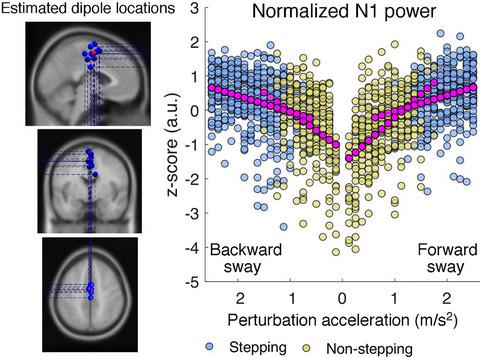当前位置:
X-MOL 学术
›
Eur. J. Neurosci.
›
论文详情
Our official English website, www.x-mol.net, welcomes your feedback! (Note: you will need to create a separate account there.)
Cortical responses to whole-body balance perturbations index perturbation magnitude and predict reactive stepping behavior
European Journal of Neuroscience ( IF 3.698 ) Pub Date : 2020-09-15 , DOI: 10.1111/ejn.14972 Teodoro Solis‐Escalante 1 , Mitchel Stokkermans 1, 2 , Michael X. Cohen 2 , Vivian Weerdesteyn 1, 3
European Journal of Neuroscience ( IF 3.698 ) Pub Date : 2020-09-15 , DOI: 10.1111/ejn.14972 Teodoro Solis‐Escalante 1 , Mitchel Stokkermans 1, 2 , Michael X. Cohen 2 , Vivian Weerdesteyn 1, 3
Affiliation

|
The goal of this study was to determine whether the cortical responses elicited by whole-body balance perturbations were similar to established cortical markers of action monitoring. Postural changes imposed by balance perturbations elicit a robust negative potential (N1) and a brisk increase of theta activity in the electroencephalogram recorded over midfrontal scalp areas. Because action monitoring is a cognitive function proposed to detect errors and initiate corrective adjustments, we hypothesized that the possible cortical markers of action monitoring during balance control (N1 potential and theta rhythm) scale with perturbation intensity and the eventual execution of reactive stepping responses (as opposed to feet-in-place responses). We recorded high-density electroencephalogram from eleven young individuals, who participated in an experimental balance assessment. The participants were asked to recover balance following anteroposterior translations of the support surface at various intensities, while attempting to maintain both feet in place. We estimated source-resolved cortical activity using independent component analysis. Combining time-frequency decomposition and group-level general linear modeling of single-trial responses, we found a significant relation of the interaction between perturbation intensity and stepping responses with multiple cortical features from the midfrontal cortex, including the N1 potential, and theta, alpha, and beta rhythms. Our findings suggest that the cortical responses to balance perturbations index the magnitude of a deviation from a stable postural state to predict the need for reactive stepping responses. We propose that the cortical control of balance may involve cognitive control mechanisms (i.e., action monitoring) that facilitate postural adjustments to maintain postural stability.
中文翻译:

皮质对全身平衡扰动指数扰动幅度的反应并预测反应性踏步行为
本研究的目的是确定全身平衡扰动引起的皮层反应是否与既定的皮层动作监测标志物相似。平衡扰动施加的姿势变化会引起强大的负电位 (N1) 和在中额头皮区域记录的脑电图中 theta 活动的快速增加。因为动作监测是一种认知功能,用于检测错误并启动纠正调整,我们假设平衡控制期间动作监测的可能皮层标记(N1 电位和 theta 节律)随扰动强度和反应性步进响应的最终执行(如与足部就地反应相反)。我们记录了 11 个年轻人的高密度脑电图,谁参加了实验平衡评估。参与者被要求在支撑表面以各种强度前后平移后恢复平衡,同时尝试将双脚保持在适当的位置。我们使用独立成分分析估计了源解析的皮质活动。结合单次试验反应的时频分解和组级一般线性建模,我们发现扰动强度和步进反应之间的相互作用与来自中额叶皮层的多个皮质特征之间存在显着关系,包括 N1 电位和 theta、alpha , 和 beta 节奏。我们的研究结果表明,皮层对平衡扰动的反应反映了偏离稳定姿势状态的程度,以预测对反应性步进反应的需求。
更新日期:2020-09-15
中文翻译:

皮质对全身平衡扰动指数扰动幅度的反应并预测反应性踏步行为
本研究的目的是确定全身平衡扰动引起的皮层反应是否与既定的皮层动作监测标志物相似。平衡扰动施加的姿势变化会引起强大的负电位 (N1) 和在中额头皮区域记录的脑电图中 theta 活动的快速增加。因为动作监测是一种认知功能,用于检测错误并启动纠正调整,我们假设平衡控制期间动作监测的可能皮层标记(N1 电位和 theta 节律)随扰动强度和反应性步进响应的最终执行(如与足部就地反应相反)。我们记录了 11 个年轻人的高密度脑电图,谁参加了实验平衡评估。参与者被要求在支撑表面以各种强度前后平移后恢复平衡,同时尝试将双脚保持在适当的位置。我们使用独立成分分析估计了源解析的皮质活动。结合单次试验反应的时频分解和组级一般线性建模,我们发现扰动强度和步进反应之间的相互作用与来自中额叶皮层的多个皮质特征之间存在显着关系,包括 N1 电位和 theta、alpha , 和 beta 节奏。我们的研究结果表明,皮层对平衡扰动的反应反映了偏离稳定姿势状态的程度,以预测对反应性步进反应的需求。


























 京公网安备 11010802027423号
京公网安备 11010802027423号